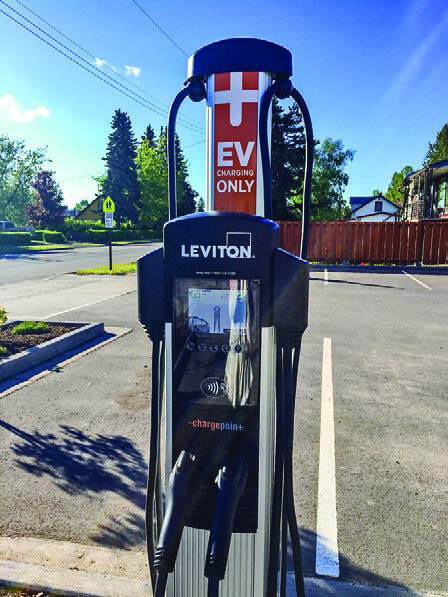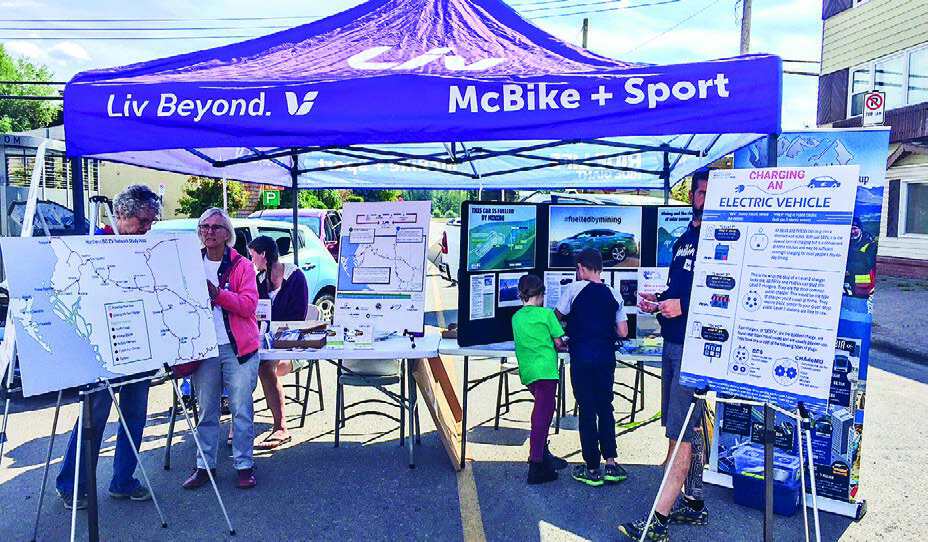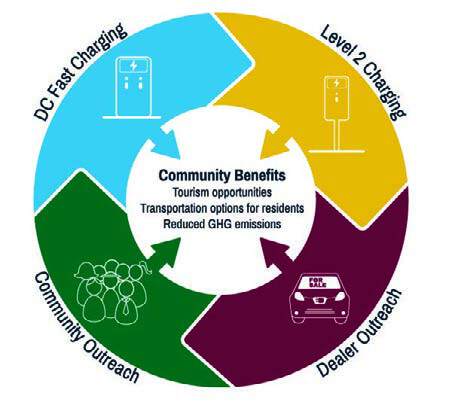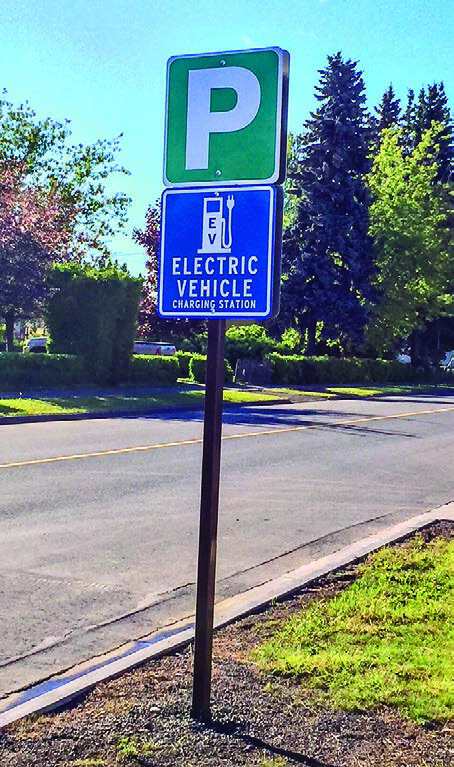A boom is coming on four wheels for B.C.’s mining and mineral exploration industry.
AME members throughout the province are actively engaged in exploring, discovering and developing projects for minerals and metals that are necessary in realizing a clean energy revolution – notably electric vehicles and the supporting infrastructure. Let’s also not forget the increased requirement for key minerals and metals in other clean technology solutions such as wind turbines, solar cells, LED light bulbs and high-density batteries.
According to the World Bank, many of these new energy technologies are in fact more material-intensive than traditional fossil-fuel-based energy systems. This increasing demand underscores the importance of base metals such as copper, nickel, zinc and molybdenum and associated products including germanium and the rareearth minerals that are also critical for products in our clean energy future.
Literally from the ground up, B.C.-based exploration, development and mining companies are critical to the rapidly expanding clean energy economy. And B.C.’s world-class expertise, combined with a strong regulatory system, anti-corruption and labour laws, lead the world in responsible exploration and extraction of minerals and metals, resulting in a greener economy and specifically contributing to the number of clean electric vehicles and supporting infrastructure.
The number of electric vehicles (EVs) in B.C. is less than 9,000 now, but researchers estimate that number will increase to 300,000 by 2030. One of the barriers today for adoption of EVs is the necessary EV infrastructure and vehicle stock. That growing web of electric vehicle requirements – charging stations, local EV dealers and services – requires a critical expansion beyond the Lower Mainland towards northern British Columbia and into rural communities and towns that can directly increase their benefit from the mineral exploration and mining industry. With the support of organizations including BC Hydro, Fortis BC, the province of B.C.’s Ministry of Energy, Mines and Petroleum Resources and non-profit support groups such as the Community Energy Association, these benefits and the target for increasing EV usage makes the 2030 target achievable.

Local EV drivers share their northern B.C. travel experience at the Smithers Ride and Drive event, 2018; (above) EV charging station operated by the Town of Smithers 
An integrated approach to EV network planning to maximize community benefits. 
Directional signage that will soon become familiar along the Highway 16 corridor.
For example, a program aimed to increase rural EV infrastructure, Accelerate Kootenays, is described as “Canada’s first community-driven, collaborative strategy to build a clean transportation network.” The network contains Direct Current Fast Chargers (DCFC) as well as Level 2 charging stations along highways 1, 3, 6, 93 and 95 throughout the Kootenays. Appropriately enough, along the Highway 3 corridor, this network connects the historic gold-mining town of Greenwood in the west with the metallurgical coal mining centre of Sparwood in the east – both towns that are continuing to see exploration to outline the deposits that will continue to power the development of clean energy materials into the future.
The EV network expansion along highways 16, 97 and 5 involves 43 regional governments working together toward a network stretching from the Thompson-Nicola region, through Kamloops and Prince George, all the way to Haida Gwaii – a web of infrastructure for electric vehicle support and charging stations spanning 2,780 kilometres. The expansion entitled Highway 16/97 Electric Vehicle (EV) Network Feasibility Study includes a network of charging stations (both DCFCs and Level 2 stations) as well as public education and car dealer outreach.
Highway 3 and Minerals for Electric Cars – Benefits for Rural B.C.
The term “electric car” covers three types of vehicle: Battery Electric Vehicles (BEVs), Hybrid Electric Vehicles (HEVs) and Plug-in Hybrid Electric Vehicles (PHEVs). BEVs are wholly electric and are powered only by batteries that are recharged at a plug-in station. HEVs are powered by a combination of an internal combustion engine and an electric motor; the battery is recharged either by the petrol engine or the kinetic energy of the car. PHEVs operate in the same way as HEVs, but their batteries can also be recharged at a plug-in station.
The battery chemistry of BEVs, HEVs and PHEVs varies but is dominated by lithium compounds; lithium cobalt oxide (LCO), lithium nickel manganese cobalt oxide (NMC), lithium nickel cobalt aluminium oxide (NCA) and lithium iron phosphate (LFP). Batteries with greater nickel content have higher energy density and so are projected to capture more market share going forward.
Other metals expected to increase in demand include copper, lead, titanium and silicon, which are used in the wiring and construction of batteries. Copper is also used to connect modules and cells in battery packs and in charging infrastructure. Petrol cars use up to 23 kg of copper, whilst an HEV requires 40 kg and a PHEV, up to 60 kg. Car bodies will remain predominately made of steel alloys to satisfy safety requirements.
Driving along Highway 3 eastwards gives a snapshot of how British Columbian communities may profit from increased demand for these minerals:
- Princeton benefits from copper mining and exploration with one active mine, Copper Mountain (Copper Mountain Mining Corp.) and Miner Mountain (Sego Resources Inc.) which is prospecting for polymetallic deposits of copper and gold. The Copper Mountain Mine produced 75,800 lbs. of Cu in 2017, with an additional 23,600 oz. of Au, and 277,000 of Ag. The mine has a projected life of 16 years, which could be extended by 10 years with ongoing exploration at its New Ingerbelle prospect. It employs about 425 people, and an additional 10 companies provide goods and services totalling a spend of $1.35 million to the mining companies operating in this area.
- Greenwood and Grand Forks are reaping rewards from higher commodity prices, which have seen increased exploration activity as copper and lead are subsidiary minerals in the region’s gold seams. Prospecting around Gold Drop (GGX Gold Corp.) has confirmed a positive correlation of Au with elevated amounts Ag, Pb and Cu. Sampling on the historic mining areas of May Mac, Golden Crown, Lexington and the Phoenix (Golden Dawn Minerals Inc.) highlight several Au-Ag and Au-Cu targets for future drilling.
- Castlegar and Salmo historically had several small mines producing lead, zinc, silver and tungsten. Present-day exploration around Jackpot and Jersey-Emerald (Margaux Resources Ltd.) and Swift-Katie (Valterra Resource Corp.) have outlined various potential polymetallic deposits of Zn, Pb, Ag, Au, Cd, as well as W (with minor Mo and Cu).
- The Trail smelter (Teck Resources Limited) produces approximately 305,000 tonnes of refined zinc, 99,000 tonnes of refined lead and up to 25 M oz. of silver annually. Trail operations employ about 1,400 people and locally procure around $124 million a year in goods and services, which in turn generates approximately $11 million in municipal revenue.
- Around Sparwood, Teck Coal Ltd.’s five operating coal mines in the Elk Valley account for 70 per cent of Canada’s coal production and exports. Metallurgical coal predominates (85 per cent) and this is used to produce the coke necessary for iron and steel-making. In 2017, 28 Mt of metallurgical coal was mined. Sparwood has the highest concentration of suppliers, with approximately 55 companies serving this region, resulting in a $270-million spend on procurement. – Natasha Gibson
“It’s a chicken-and-egg thing. We need the infrastructure in place to reduce the range anxiety for people who might want to drive an electric vehicle,” says Janice Keyes, senior manager with Community Energy Association (CEA). The CEA is a 20-year-old non-profit organization supporting local governments and First Nations on energy use and engagement across the province. With this second phase, the CEA is establishing the necessary infrastructure in more isolated rural municipalities for electric vehicles to get up to speed.

This collective effort knits the various regions together to make them a continuous travel corridor. “We are looking at expansion on highways 16, 97 and now Highway 5 as a cross-regional collaboration,” says Keyes. The new phase of EV infrastructure-building hopes to encourage a significant increase in EV adoption by the public as the infrastructure needed for travel grows, a larger echo of what occurred at the completion of Accelerate Kootenays. The larger northern and central B.C. network covers twice the number of towns and regions and provides opportunities to support local economic development and benefits for communities previously underserved by a green vehicle network.
When considering these projects that encourage the move towards a low-carbon economy, diversifying local economies and increasing the profitability of EV usage, Bryan Cox, president and CEO of the Mining Association of British Columbia (MABC), notes that “Minerals and metals are very important and their importance increases in our very fast transition to a lower-carbon economy. For example, when you think of clean energy vehicles, they can require up to four times the amount of copper to produce than a standard combustion engine.”
Communicating to the public that minerals and metals are enablers of clean energy applications and products is vital and will further support the growth of EVs and the infrastructure that supports them.
“I drive an EV and in B.C., the electricity to power my car comes from renewable hydroelectric power, another piece of the clean energy puzzle that sets B.C. apart from other jurisdictions,” says Edie Thome, president and CEO of the Association for Mineral Exploration BC (AME). “I am proud that our members, along with Indigenous partners and local communities, are contributing in such a meaningful way to advancing a green economy, and the opportunity for us to contribute in a bigger way is here. Right now, B.C. needs to be ramping up to further position itself as the leader in the lower-carbon economy. By working together, we can lead through our greatest assets: our geology and our people.”
British Columbia is a world leader in mineral exploration and development expertise. Exporting this expertise as well as critical technology metals such as copper, silver and molybdenum will put money back into communities across the province. It will also serve to build our province’s reputation as a world-class jurisdiction in which to invest.


